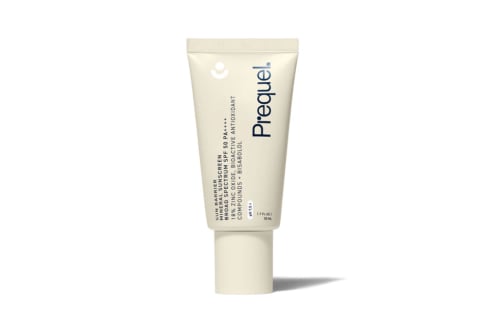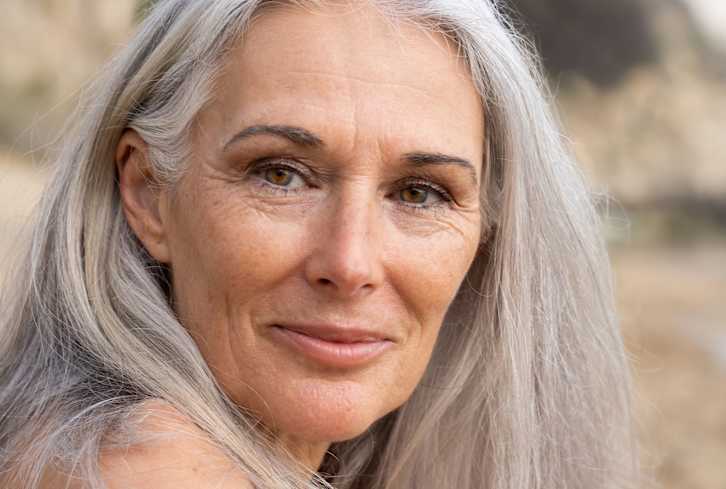Advertisement
Are "Skin Age" Scanners Great Or Gimmicky? A Beauty Editor's Deep Dive


The first time I uncovered my skin’s “true age,” I was skeptical. Not because I was unhappy with the result (my skin and I were actually the same age!), but because the experience felt a tad… gimmicky.
I was not in a derm’s office but at an editor event sporting a full face of makeup when the machine congratulated me on my youthful appearance—call me guarded, but I left feeling not so convinced.
I even brought up the dilemma to mbg’s beauty director Alexandra Engler on an episode of Clean Beauty School. “I do think context matters,” she told me about high-tech skin scanners. “There is some decent research that goes into it, but there's a lot of knockoff versions… It's all about if you're seeing somebody who's reputable.”
Fast forward a few weeks later, and I had the chance to try the THÉRASCAN skin analyzer at New York City’s Thérapie Clinic—a far more fitting context with nurse practitioners and medical estheticians. Allow me to walk through everything I learned, plus what to expect for your own skin analysis.

What is THÉRASCAN?
The THÉRASCAN facial skin analyzer is a machine that measures the surface and deeper levels of the skin using digital imagery—namely RGB visible light, PL polarized light, and UV spectrum imaging technology—combined with artificial intelligence to give you a snapshot of your overall skin health. This technology has the ability to capture microscopic changes in the skin, including fine lines and wrinkles, pore size, texture, UV damage, moisture, and pigmentation.
Despite how high-tech that sounds, it’s completely noninvasive. You just rest your chin onto the stand and wait about 60 seconds for the machine to analyze your complexion. The process reminds me of retinal imaging you might receive during an eye exam: easy and totally painless.
The technology did sound similar to other skin analyzers I’ve tried, so I asked Katie McGlade, president international at Thérapie Clinic, what makes this machine more advanced. Here, she lists some standout features:
- Epidermal skin analysis: demonstrates color of depth, property of the skin, and other skin problems
- Dermal skin analysis: showcases potential skin disorders on dermal layer
- Wrinkle analysis: assesses property, density, and dep
- Speckles analysis: analyzes depth area, size, and density
“Additionally, it grades an individual’s skin features relative to others of the same age and skin type,” she says. It does tell you your skin’s “true age,” but the nurse practitioner I spoke to said that’s actually the least important aspect of the assessment. Rather than spitting out an arbitrary age, it’s more important to recognize your unique concerns and track their progress over time. I couldn’t agree more.
To that end, THÉRASCAN is much stricter than other skin analyzers I’ve tried. Some machines are easy to please, but the nurse practitioners I spoke to even considered this one a bit harsh.

3 benefits of THÉRASCAN technology
You can find a few different analyzers on the market, so it’s important to find a reputable brand. Here’s what you can expect from a high-quality device:
Detects early signs of skin aging
Your skin ages as you do, and what a privilege it is! That said, some of the classic concerns that come with skin aging (fine lines, sagging, pigmentation), aren’t noticeable to the naked eye until they become more severe. And those woes don’t happen all at once—they occur slowly over years of UV exposure, environmental aggressors, hormone fluctuations, etc.
The THÉRASCAN analyzer can help you pinpoint those subtle changes before they become a problem, so you can treat and protect your skin according to the issues that matter to you most.
Helps curate a treatment plan and routine
When you receive a THÉRASCAN analysis, the estheticians at Thérapie use your results to develop a tailored treatment plan. “Based on the client’s wrinkle depth, hydration levels, pigmentation spots, [and] acne, our estheticians will create a tailored skin care and treatment plan suited to the main concerns the client has,” says McGlade.
It’s why Thérapie offers the analysis before opting for one of their services. Before booking just any treatment—be it a Hydrafacial, peel, laser, etc.—it's important to know which option is best for your skin type and concern. The skin analysis can help you do just that.
Helps track progress
What’s more, you can create a profile on the THÉRASCAN machine, which allows you to follow how your skin responds to products and treatments over time. According to McGlade, the estheticians use the technology to “better track treatment results,” too.
What to expect
I booked a THÉRASCAN consultation at Thérapie so I can assess the experience for myself. There wasn't any groundbreaking news from my skin’s appearance, but I did learn some interesting tidbits!
Before
It’s not necessary to prep before the appointment. However, I did make sure to take extra care of my skin a few days leading up to it (i.e., getting plenty of rest, drinking tons of water, loading up on skin foods), so I’d receive the best results possible. Chances are if I had my skin analyzed after a late night with multiple glasses of wine and salt-heavy foods, I might wind up with a skewed result.
If you are getting a treatment immediately after the scan—I booked mine separately, but I understand if you want a one-and-done experience—make sure you skip exfoliants, retinol, and any harsh actives a few days before your appointment. Even a gentle Hydrafacial provides a pretty deep clean, and you don’t want to aggravate your skin by piling on intense actives beforehand.
During
I placed my face inside the scanner and let the machine work its magic. After 60 seconds, my results loaded on the accompanying screen.
In addition to the imaging, the machine compares each result to others of the same age and skin type and grades it “poor,” “general” (meaning OK), and “good,” though a “good” is extremely rare. In fact, my aesthetician said he’s never even seen a “good” score before I walked in the room (more on that in just a moment!).
Overall, the analyzer didn’t tell me anything groundbreaking I didn’t already know, but I did learn some interesting tidbits. Here are some of the results:

- Moisture: The pink areas are where my skin is most dry, which, unsurprisingly, is most concentrated on my cheeks and forehead.
- Pores: My overall pore size was “poor,” though I have a small number of large pores. My esthetician tells me this result is classic for those with combination skin.
- UV damage: The red color denotes visible damage, while green refers to non visible damage. I received a “general” in this regard
- UV pigmentation: Dark spots are my main concern, so I wasn’t surprised to see a “poor” score here.
- Wrinkle quality: I earned a “good” here, which was the highest score my esthetician has ever seen! I have a pesky line right underneath the left side of my nose, so I wasn’t surprised to se the machine pick it up quickly.
- Texture & elasticity: My score was “general,” which is common for people in my age group, my esthetician says.
- Sensitivity: I’m most sensitive on my cheeks, as you can see here, but also on a little spot on my chin. I tend to experience breakouts on my chin, which is partly hormonal but makes me wonder how much of that is due to general inflammation.
- In 5 years: This image predicts how your skin will look in five years without any skin care intervention. Without any attention, my dark spots would become more apparent (not surprising, as they are my biggest concern right now!).
After
Based on my results, my esthetician recommended a brightening peel. Pigmentation and tone are my main concerns, both of which were only emphasized by the THÉRASCAN technology. I booked my appointment two weeks out (I had a facial recently, otherwise I’d do it right then!), and headed back to Thérapie with a fresh face.

After cleansing my skin, the esthetician applied a vitamin C-rich mango peel for a few minutes, followed by a hydrating enzyme mask to further brighten my complexion. A few hydrating serums, a layer of moisturizer, and I was out the door.
I didn’t experience any flaking post-treatment (common with peels), as this was a very gentle version. Still, I stopped using harsh actives (retinol, AHAs, etc.), for five days, instead opting for nourishing, hydrating serums and creams—and of course, SPF.
Shop my aftercare routine:
Who it’s best for & who should skip it
Anyone can benefit from a skin analyzer. If you’re curious about your skin’s main concerns and aren’t sure where to start, a quick scan can help you identify the areas in which you should probably pay the most attention.
Now, is it absolutely necessary? Of course not. If you’re confident in your skin goals, you can go ahead and book any treatment you please without the extra layer of info. For me, the THÉRASCAN only confirmed my biggest skin concerns (pigmentation and moisture), which is certainly helpful.
That said, it didn’t tell me anything I didn’t already know, aside from the spot of sensitivity on my chin—that I was surprised by! I’m now much more gentle on the chin area, and I have noticed less inflammation and breakouts crop up since.
Essentially, if you’re someone who needs extra help navigating the types of facials out there, the additional scanning step can help you get the most bang for your buck. It’s more of a nice-to-know than a need-to-have; if you do opt for the analysis, just make sure you find a reputable clinic that uses the most updated technology.
The takeaway
Skin age readers: great or gimmicky? With the right context (i.e., in a med clinic or derm’s office) and a high-quality machine, these analyzers can be immensely helpful in curating a treatment plan or targeted skin care routine.
That said, it’s important to not get too caught up in the grading details. You are the expert in your own skin, so give it all the gold stars you please.





















